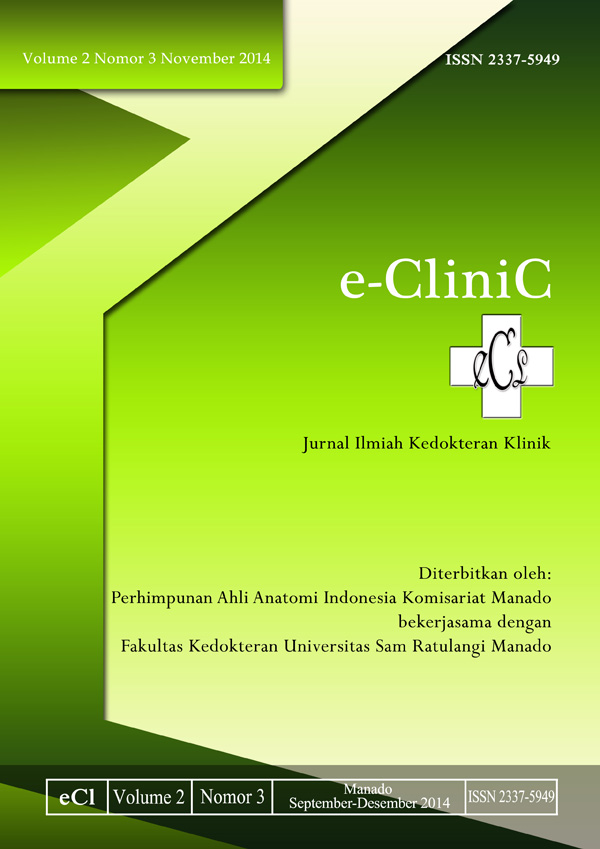GAMBARAN HASIL CT SCAN KEPALA PADA PENDERITA DENGAN KLINIS STROKE NON-HEMORAGIK DI BAGIAN RADIOLOGI FK. UNSRAT / SMF RADIOLOGI BLU RSUP PROF. DR. R. D KANDOU MANADO PERIODE JANUARI 2011- DESEMBER 2011
DOI:
https://doi.org/10.35790/ecl.v2i3.6011Abstract
Abstract: Stroke is the most common of neurologic manifestations and easily recognizable from the other neurologic diseases due to the early onset of sudden in a short time. Stroke as clinical diagnosis was divided to hemorrhagic stroke and ischemic stroke. In hemorrhagic stroke there is a rupture in blood vessel so the blood flow became abnormal and bleeds into surrounding brain and damage it. In ischemic stroke the blood flow heading to the brain is interrupted due to atherosclerosis process. The purpose of this study is to know about description of head CT scan in patient with clinical diagnonis of stroke non hemorrhagic in Department/SMF Radiology Faculty Of Medicine UNSRAT BLU RSUP Prof. Dr. R. D. Kandou Manado period on 1st January 2011 – 31st December 2011. Methods: The study design was a retrospective descriptive study. The data are from request form sheet and radiographic response in the Department of Radiology and processed in descriptive. Results: Base on 163 data of stroke patients obtained, 74 patients diagnosed with infarction stroke (45,4%). Male had more (59,5%) than female (40,5%). For age group, 60-79 is the largest with 33 patients (44,6%). Area with most lesion was in parietal dextra lobe with 8 cases (10,8%). Most cases was happened in August with 10 cases (13,5%). Conclusion: Patients with radiology diagnosis infarction stroke, the most common infarction location is in parietal dextra area.
Keywords: CT Scan, Infarction Stroke, Parietal Dextra.
Â
Â
Abstrak: Stroke merupakan salah satu manifestasi neurologik yang umum, dan mudah dikenal dari penyakit-penyakit neurologik lain karena mula timbulnya mendadak dalam waktu yang singkat. Stroke sebagai diagnosis klinis terbagi menjadi stroke hemoragik (pendarahan) dan stroke non-hemoragik (iskemik). Pada stroke hemoragik pembuluh darah pecah sehingga aliran darah menjadi tidak normal dan darah yang keluar merembes masuk ke dalam suatu daerah di otak dan merusaknya. Sedangkan pada stroke non-hemoragik aliran darah ke otak terhenti karena aterosklerosis atau bekuan darah yang telah menyumbat suatu pembuluh darah, melalui proses aterosklerosis. Tujuan penelitian ini adalah untuk mengetahui gambaran hasil CT scan kepala pada penderita dengan klinis stroke non-hemoragik di Bagian Radiologi FK. Unsrat / SMF Radiologi BLU RSUP Prof. dr. R. D Kandou Manado periode Januari 2011- Desember 2011. Metode: Penelitian ini merupakan penelitian deskriptif retrospektif dengan memanfaatkan data sekunder berupa lembaran permintaan & jawaban CT scan kepala yang terdapat di bagian Radiologi BLU RSUP Prof. Dr. R. D. Kandou Manado periode 1 Januari 2011 – 31 Desember 2011. Hasil penelitian: Berdasarkan 163 data pasien yang didapatkan, 74 pasien didiagnosis dengan stroke infark (45,4%). Laki-laki lebih banyak (59,5%) dari perempuan (40,5%). Kelompok umur 60-79 merupakan kelompok umur terbanyak yaitu 33 pasien (44,6%). Daerah lesi terbanyak adalah pada daerah parietalis dextra dengan 8 kasus (10,8%). Kasus terbanyak terjadi pada bulan agustus dengan 10 kasus (13,5%). Simpulan: Pada pasien dengan diagnosis radiologi stroke infark, lokasi infark yang paling banyak muncul adalah terdapat pada daerah parietal dextra.
Kata kunci: CT Scan, Stroke Infark, Parietal Dextra.
Downloads
How to Cite
Issue
Section
License
COPYRIGHT
Authors who publish with this journal agree to the following terms:
Authors hold their copyright and grant this journal the privilege of first publication, with the work simultaneously licensed under a Creative Commons Attribution License that permits others to impart the work with an acknowledgment of the work's origin and initial publication by this journal.
Authors can enter into separate or additional contractual arrangements for the non-exclusive distribution of the journal's published version of the work (for example, post it to an institutional repository or publish it in a book), with an acknowledgment of its underlying publication in this journal.
Authors are permitted and encouraged to post their work online (for example, in institutional repositories or on their website) as it can lead to productive exchanges, as well as earlier and greater citation of the published work (See The Effect of Open Access).







